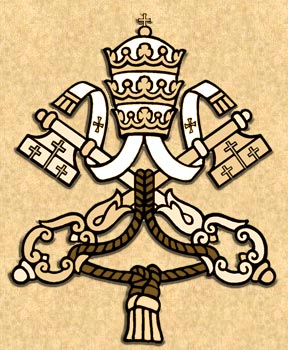Most Catholics think of St. Peter’s as the pope’s main church, but they are wrong. St. John Lateran is the pope’s church, the cathedral of the Diocese of Rome where the Bishop of Rome presides.
The residence of the Popes which was named the Lateran Palace was built by Lateranus Palutius, whom Nero put to death to seize his goods. It was given in the year 313 by Constantine the Great to Saint Miltiades, Pope, and was inhabited by his successors until 1308, when they moved to Avignon. The Lateran Basilica built by Constantine near the palace of the same name, is the first Basilica of the West. Twelve councils, four of which were ecumenical, have assembled there, the first in 649, the last in 1512.
If for several centuries the Popes have no longer dwelt in the Palace, the primacy of the Basilica is not thereby altered; it remains the head of all churches. Saint Peter Damian wrote that “just as the Saviour is the Head of the elect, the church which bears His name is the head of all the churches. Those of Saints Peter and Paul, to its left and its right, are the two arms by which this sovereign and universal Church embraces the entire earth, saving all who desire salvation, warming them, protecting them in its maternal womb.”
The Divine Office narrates the dedication of the Church by the Pope of Peace, Saint Sylvester:
“It was the Blessed Pope Sylvester who established the rites observed by the Roman Church for the consecration of churches and altars. From the time of the Apostles there had been certain places dedicated to God, which some called oratories, and others, churches. There, on the first day of the week, the assembly was held, and there the Christian people were accustomed to pray, to hear the Word of God, and to receive the Eucharist. But never had these places been consecrated so solemnly; nor had a fixed altar been placed there which, anointed with sacred chrism, was the symbol of Our Lord Jesus Christ, who for us is altar, victim and Pontiff. But when the Emperor Constantine through the sacrament of Baptism had obtained health of body and salvation of soul, a law was issued by him which for the first time permitted that everywhere in the world Christians might build churches. Not satisfied to establish this edict, the prince wanted to give an example and inaugurate the holy labors. Thus in his own Lateran palace, he dedicated a church to the Saviour, and founded the attached baptistry under the name of Saint John the Baptist, in the place where he himself, baptized by Saint Sylvester, had been cured of leprosy. It is this church which the Pontiff consecrated in the fifth of the ides of November; and we celebrate the commemoration on that day, when for the first time in Rome a church was thus publicly consecrated, and where a painting of the Saviour was visible on the wall before the eyes of the Roman people.”
When the Lateran Church was partially ruined by fires, enemy invasions, and earthquakes, it was always rebuilt with great zeal by the Sovereign Pontiffs. In 1726, after one such restoration, Pope Benedict XIII consecrated it anew and assigned the commemoration of that event to the present day. The church was afterwards enlarged and beautified by Popes Pius IX and Leo XIII.
Pope Innocent X commissioned the present structure in 1646. One of Rome’s most imposing churches, the Lateran’s towering facade is crowned with 15 colossal statues of Christ, John the Baptist, John the Evangelist and 12 doctors of the Church. Beneath its high altar rest the remains of the small wooden table on which tradition holds St. Peter himself celebrated Mass.
Unlike the commemorations of other Roman churches (St. Mary Major, Sts. Peter and Paul), this anniversary is a feast. The dedication of a church is a feast for all its parishioners. St. John Lateran is, in a sense, the parish church of all Catholics, for it is the pope's parish, the cathedral church of the Bishop of Rome. This church is the spiritual home of the people who are the Church.
"What was done here, as these walls were rising, is reproduced when we bring together those who believe in Christ. For, by believing they are hewn out, as it were, from mountains and forests, like stones and timber; but by catechizing, baptism and instruction they are, as it were, shaped, squared and planed by the hands of the workers and artisans. Nevertheless, they do not make a house for the Lord until they are fitted together through love" (St. Augustine, Sermon 36>).
Visiting Holy Rosary Cathedral in Toledo
3 weeks ago










6 comments:
I reckon St Helen had a lot to do with the Lateran and what her son did with it.
She's one of our family saints- my 14 yr old has her as her Confirmation saint and my youngest is named for her.
I have awarded you :)
God bless
Great post..& thanks for stopping by..
Salve Maria! Jackie and Mum6kids
Not too many Catholics know about the significance of the Lateran Basilica. Part of the intention of my blog is to teach about Catholic History.
The working hand of God can be seen in the history of the Catholic Church through the ages.
I really like your blog and i really appreciate the excellent quality content you are posting here for free for your online readers. thanks peace sandro
Thank you Sandro
Thank you amazing blog, do you have twitter, facebook or something similar where i can follow your blog
Sandro Heckler
Post a Comment